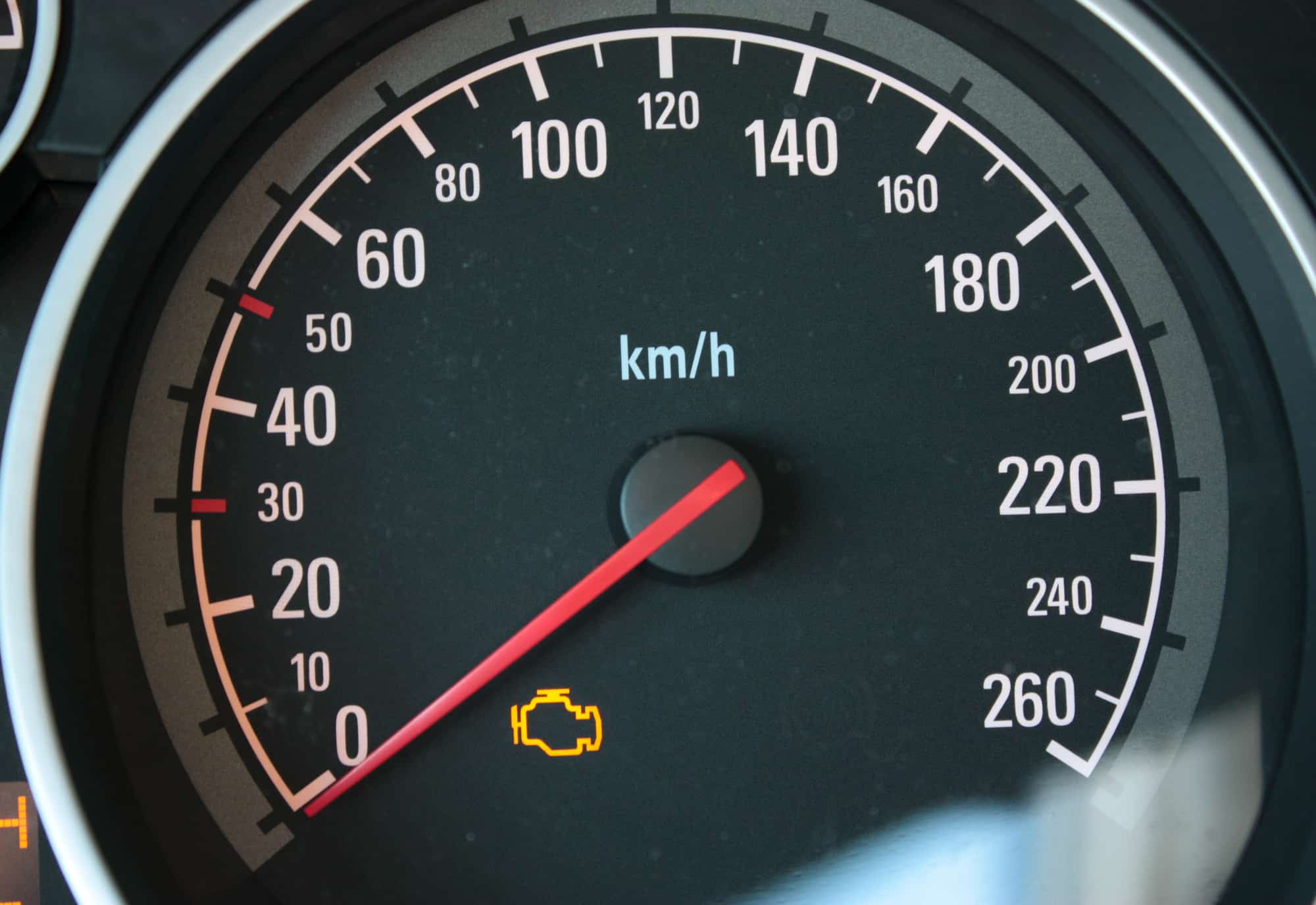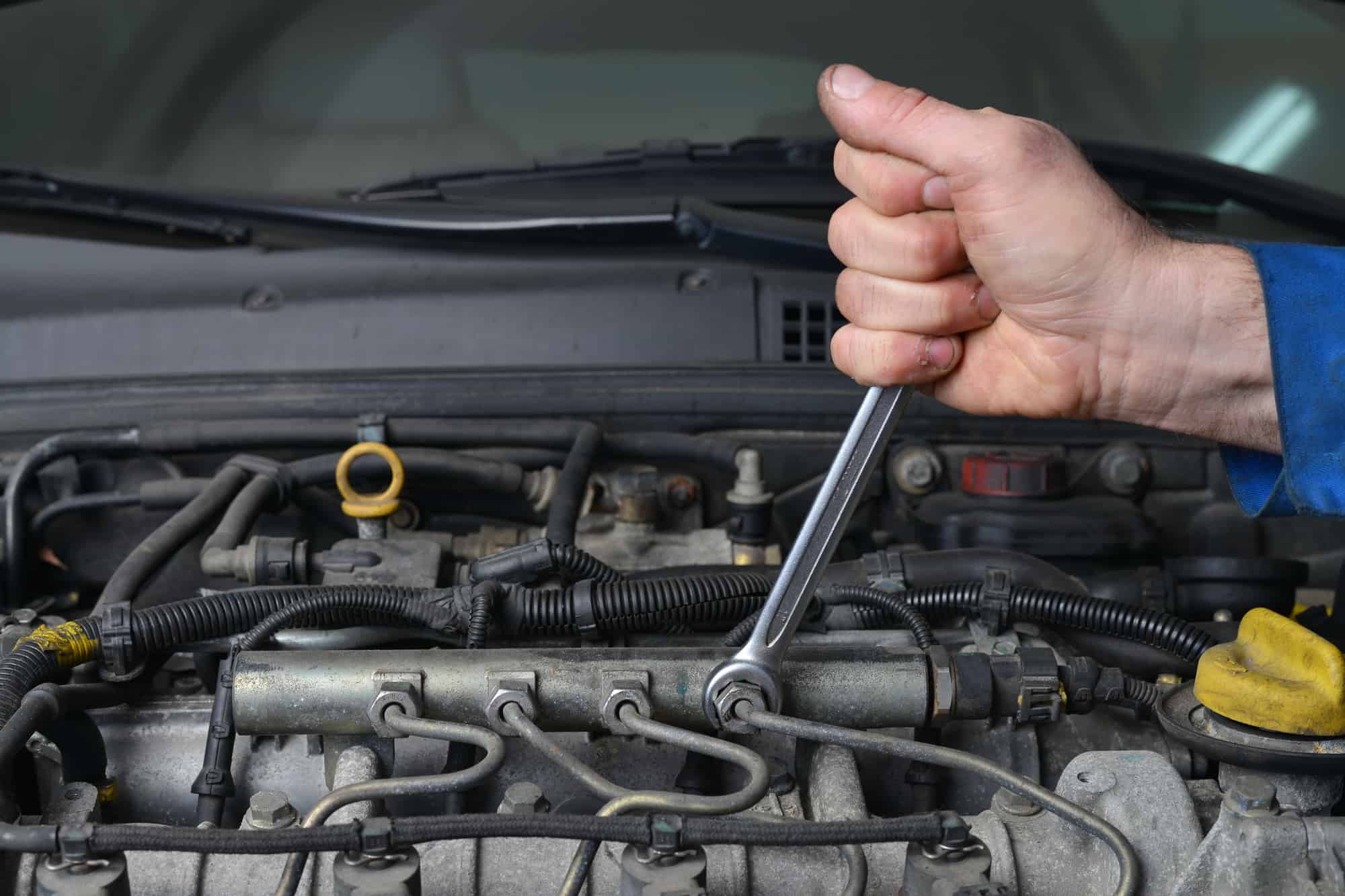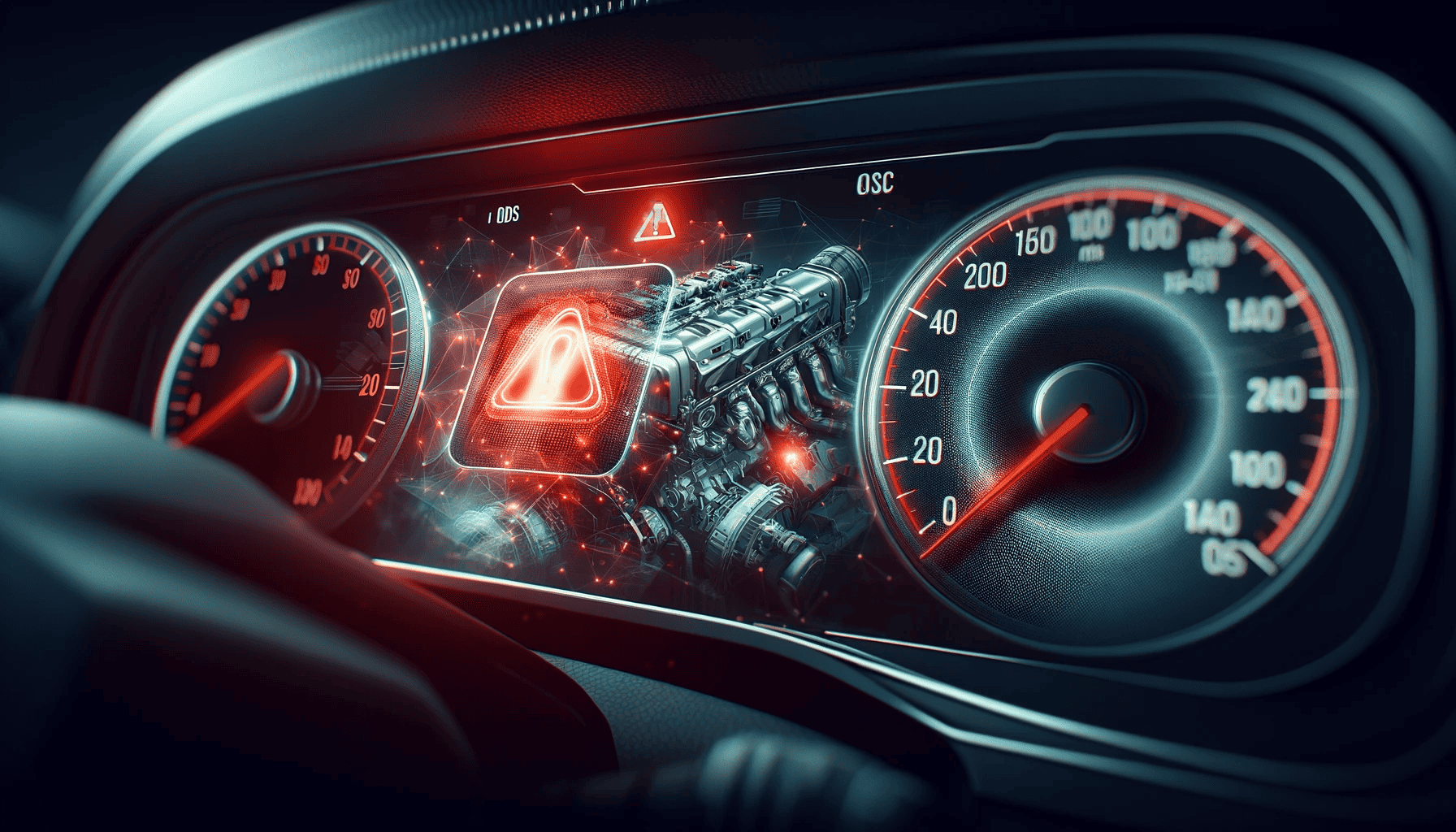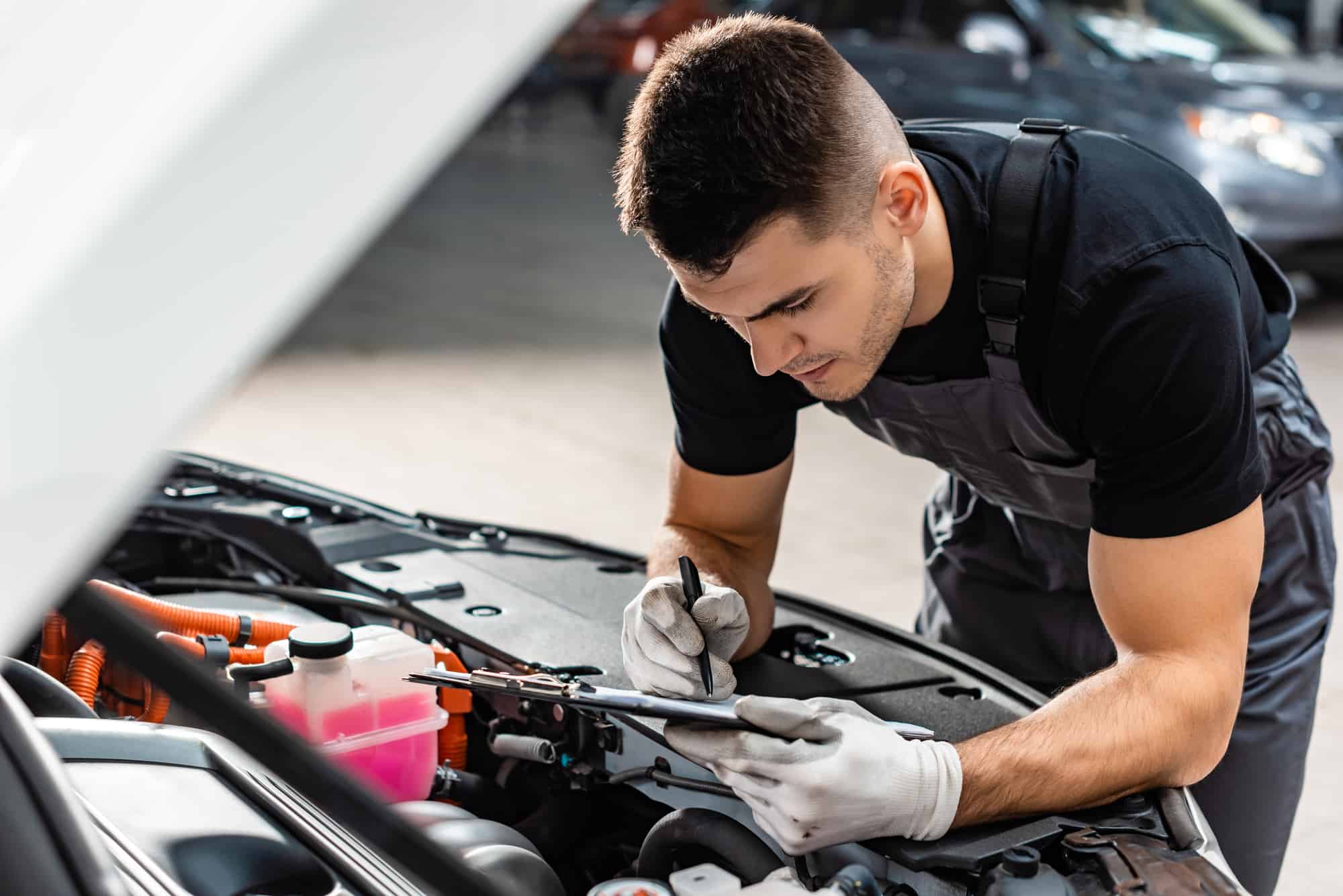In general, if the check engine light is on but the car runs fine then there could be a problem with one or more engine components. Common causes for this include problems like a cylinder misfire, which may stem from various sources such as a misfiring engine, a defective ignition coil, worn-out spark plugs, a clogged fuel filter, a malfunctioning fuel injector, or a vacuum leak.
It’s usually ok to continue to drive your car as long as it’s running fine, even if the check engine light is on. You should however get it checked out of the light remains on, as it may lead to a more serious permanent engine problem.
5 Common Causes for the Check Engine Light To Come On
The check engine light is a universal warning signal on your car’s dashboard that can indicate a variety of issues with a vehicle’s engine or other systems.
While the light can be triggered for many different reasons, some causes are more common than others. In this section, we’ll explore the five most common causes of check engine light activation.
1. Loose or Damaged Gas Cap
One possible reason for the check engine light to be on, even when the car runs fine, is a loose or damaged gas cap. A gas cap that is not tight enough or has a cracked seal can cause fuel vapors to leak, leading to decreased fuel efficiency and increased emissions. In such cases, simply tightening the gas cap or replacing it can resolve the issue.
2. Malfunctioning Oxygen Sensor
A bad oxygen sensor may also result in the check engine light coming on. Oxygen (O2) sensors monitor the level of oxygen in the exhaust gases and help the engine control module (ECM) to adjust the air-fuel mixture for optimal performance and emissions.
A malfunctioning O2 sensor can cause poor fuel economy and increased emissions but may not immediately affect the car’s performance.
3. Failing Catalytic Converter
Another possible cause for the check engine light is a failing catalytic converter. The catalytic converter is responsible for reducing harmful emissions by converting them into less harmful gases.
A bad catalytic converter can lead to decreased engine performance, higher emissions, and may eventually cause the car to fail an emissions test. Often the only option to fix this problem is to replace the failing catalytic converter.
4. Faulty Ignition Coil
A faulty ignition coil can also trigger the check engine light. Ignition coils are responsible for providing the high voltage needed for the spark plugs to ignite the air-fuel mixture inside the engine cylinders.
If an ignition coil fails, it may cause misfires, reduced power, and decreased fuel efficiency, although the car might still run. Diagnosing and replacing a faulty ignition coil can help restore the engine’s performance.
5. Bad Spark Plugs
Lastly, bad spark plugs can also cause a check engine light. Spark plugs play an essential role in the combustion process and can affect fuel efficiency, engine performance, and emissions.
Worn-out or damaged spark plugs may cause misfires, poor acceleration, and reduced fuel economy. Replacing the bad spark plugs can improve the engine’s overall performance and prevent further issues.
Can Intermittent Symptoms Cause A Check Engine Light?
Sometimes when the check engine light comes on there may be intermittent symptoms that there is something wrong with the engine. These symptoms may happen when the engine is cold, or when you accelerate hard or when the engine is under heavy load.
Usually in this scenario, the car will run fine most of the time, but the check engine light will stay on all of the time.
Here are a few symptoms to watch out for:
- Intermittent Stalling: The car may stall or shut off unexpectedly while driving or idling, and then restart normally.
- Intermittent Misfires: The engine may misfire or run rough intermittently, causing a noticeable vibration or loss of power.
- Intermittent Hesitation: The car may hesitate or stumble while accelerating or driving at a consistent speed, and then resume normal operation.
- Intermittent Rough Shifting: The transmission may shift roughly or jerk intermittently, especially when changing gears.
- Intermittent Loss of Power: The car may experience a sudden loss of power or acceleration intermittently, and then resume normal operation.
How To Diagnose A Check Engine Light (Even When Your Car Is Running Fine)
1. Use a Code Reader or Scan Tool
These devices can help pinpoint the cause of the problem and save time when identifying and repairing it. Plug the code reader or scan tool into the car’s diagnostic port (usually located under the dashboard), and follow the prompts.
The device will display specific trouble codes, which can be looked up online or in the manual provided with the tool. Understanding these codes is crucial in identifying the issue behind the check engine light. Some common issues include loose or leaking gas caps and faulty sensors.
2. Auto Parts Store Assistance
Many auto parts stores offer free assistance with diagnosing check engine light issues. The store may have professionals on-site who can help read the trouble codes and decipher their meanings.
They can also recommend appropriate replacement parts and provide guidance in resolving the issue.
3. Consulting a Professional Technician
If the cause of the check engine light remains unclear after using a code reader or seeking assistance from an auto parts store, it’s best to consult a professional technician. A certified mechanic will have access to advanced diagnostic equipment and the expertise required to identify and fix the issue.
They can perform a thorough inspection, identify any underlying problems, and recommend appropriate repairs.
Practical Fixes for Your Car’s Check Engine Light
If you have worked on your car before and have some knowledge of engines and access to some tools, there are a few other things you can check:
1. Check The Mass Airflow Sensor
The mass airflow sensor (MAF) measures the amount of air entering the engine to calculate the proper amount of fuel needed for optimal performance. If the MAF sensor is dirty or malfunctioning, it can lead to the check engine light coming on even if your car runs fine.
Inspecting and cleaning the MAF sensor can fix a check engine light and ensure accurate air flow readings and maintain proper fuel to air ratio.
2. Inspect And Clean The Fuel Injectors
Another potential cause for the check engine light could be your car’s fuel injectors. These components are responsible for delivering fuel to the engine, and any issues related to them, such as clogging or leaks, can lead to the check engine light illuminating.
When you carry out a diagnostic check using an OBD reader, you may uncover some DTCs associated with faulty fuel injectors. Here are some common bad fuel injector engine codes that may trigger a check engine light:
- P0171 – System Too Lean (Bank 1): This code indicates that the air-fuel mixture in the engine’s cylinders is too lean on the bank 1 side. A leaking fuel injector can introduce more air into the cylinders, leading to a lean condition.
- P0172 – System Too Rich (Bank 1): Conversely, this code indicates that the air-fuel mixture is too rich on the bank 1 side, which could be caused by a leaking fuel injector delivering excessive fuel to the cylinders.
- P0201 to P0208 – Injector Circuit/Open Cylinder X: These codes are specific to each cylinder and indicate an open circuit or malfunction in the fuel injector circuit. A leaking fuel injector can cause electrical issues, triggering these codes.
- P0300 – Random/Multiple Cylinder Misfire Detected: A leaking fuel injector can cause irregular fuel delivery, leading to misfires across multiple cylinders, which triggers this code.
- P0174 – System Too Lean (Bank 2): Similar to P0171 but affecting bank 2, this code indicates a lean condition due to a potential fuel injector leak on that side.
- P0175 – System Too Rich (Bank 2): Similar to P0172 but affecting bank 2, this code indicates a rich condition caused by a potential fuel injector leak on that side.
Inspecting and cleaning fuel injectors is best left to an expert. If you suspect that one or more injectors are leaking, then you should get a qualified mechanic or fuel injector expert to test them and refurbish them if necessary. Learn more about diagnosing and fixing faulty fuel injectors.
3. Fuel Tank and Air Filter
The check engine light will also indicate problems related to the fuel tank or air filter. Problems with the gas cap can easily cause the light to come on, as well as a clogged air filter causing improper air supply to the engine.
These problems are easy to check. If you find that the gas cap is not tightening properly or if the air filter is dirty then replacing them may help to fix the problem with the check engine light.
4. Check the condition and state of the battery
A bad battery can cause a check engine light to turn on due to its impact on the car’s electrical system. The car’s computer system relies on a stable power source to function properly, and a bad battery can cause fluctuations in voltage that can trigger the check engine light.
If the battery is not providing the correct voltage stream that the car’s computer needs to function properly, the check engine light can turn on.
If the check engine light is on, it’s important to diagnose the issue before checking the battery. However, if you suspect that the battery may be related to the check engine light, you can simply check the battery’s voltage using a multimeter. Here are the steps:
- Turn off the car: Make sure that the car is turned off and the key is removed from the ignition.
- Open the hood: Open the hood of the car and locate the battery.
- Connect the multimeter: Connect the multimeter to the battery terminals. The red lead should be connected to the positive terminal, and the black lead should be connected to the negative terminal.
- Set the multimeter: Set the multimeter to DC voltage mode and select a range that is higher than the battery’s voltage.
- Read the voltage: Read the voltage on the multimeter. A fully charged battery should read around 12.6 volts. If the voltage is significantly lower, the battery may be weak or discharged.
If the battery is weak or discharged, it may need to be charged or replaced. However, it’s important to diagnose the issue that triggered the check engine light before addressing the battery issue to prevent any potential damage to the car’s engine or emission system. Here is more information about car battery issues and their solutions.
As an Amazon Associate we earn from qualifying purchases.










